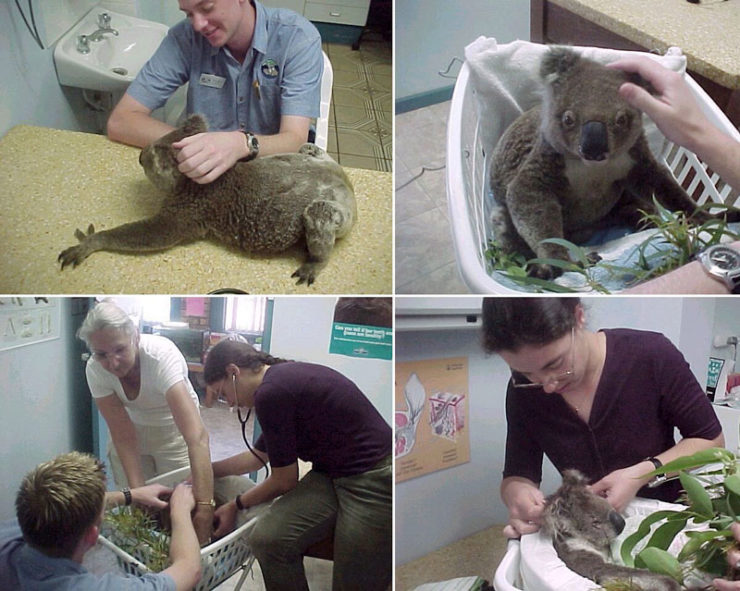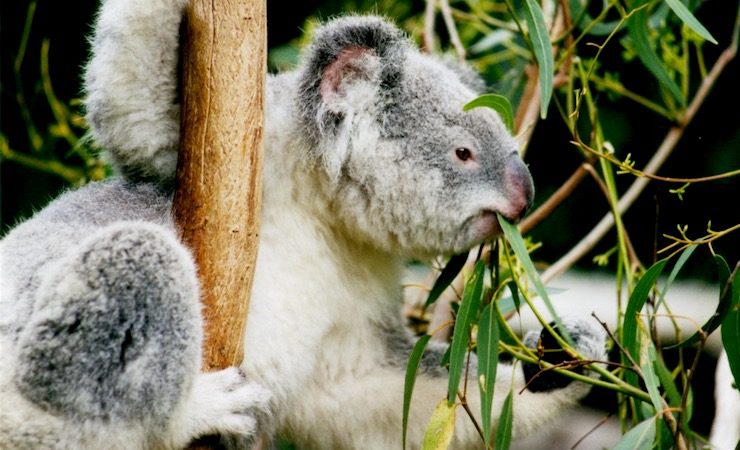In this ongoing series, we ask SF/F authors to describe a specialty in their lives that has nothing (or very little) to do with writing. Join us as we discover what draws authors to their various hobbies, how they fit into their daily lives, and how and they inform the author’s literary identity!
Most writers need day jobs.
If you have to have a day job, working as a veterinarian with Australian wildlife has to be one of the better ones out there! The opportunity to care for the koalas of the Tilligerry Peninsula, get bitten by butcher birds, buckle wandering albatrosses into the passenger seat, cure cancer in cockatoos and deal with dingoes was a large part of the appeal when I took my first full-time job in Port Stephens, New South Wales.
I left veterinary work when I became pregnant, a personal choice to limit my exposure to anaesthetics, x-rays, and injectable animal hormones. Prior to that, for five years, I worked hand-in-hand with the hard-working volunteers of the Hunter Koala Preservation Society. June Walsh and Jill Taylor were only two of the grey-haired old ladies who raised fuzzy, fist-sized koala orphans to robust adults ready for release. They’ve long since retired, but whenever a bushfire rages in our searing summer season, I am reminded of the koalas and how they’d sit tight in the trees, waiting for the flames to pass.
Fires were the third biggest killers of koalas on the Peninsula. If the smoke became too much for them, they would risk the run towards the beach and the safety of the water’s edge, only for their little feet to be badly burnt. When a koala’s claws come off, they never grow back. That animal can never climb a tree again; can never again be safe from predators. Females with joeys in the pouch can be kept in care until their offspring are old enough to leave them, but after that tragic deadline, wild animals that can’t be released into the wild can only be euthanased.
The first and second biggest threats to koalas were dog attacks and HBCs (hit by cars). Council regulations in bush-backed blocks limited the size of local pet dogs to less than fourteen kg, though I can think of a few greedy dachshunds and corgis who surpassed all prior known breed standards. The main thing was, they didn’t have the jaw strength to tear apart a koala.
As for being hit by cars, it wasn’t unusual for vehicles on the long, straight roads adjacent to the Air Force Base to reach 180 km/hour in an 80 or 100 km/h zone. When you fly jets, I suppose land speeds seem tame, and yet koalas are slow and awkward on the ground; both human and koala road tolls are posted prominently on local signage in Medowie and on Lemon Tree Passage Road.
With all of these dangers around, HKPS worked hard to raise these wee orphaned koalas. Not only did Jill and June keep koala joeys stashed in their jackets at all hours of day or night, and wheel injured animals into the surgery for health checks and medication, they also had to cut ridiculous amounts of fresh eucalyptus foliage to keep their charges happy. Koalas are pickier than you think—it’s true they can consume volumes of eucalyptus oil that would kill any other animal, but they might only want Swamp Mahogany, small leaf peppermint, bangalay, scribbly gum, paperbark for a change, and willow gum if you’re lucky. Their digestion adapts to the trees of their local area so they can get tummy troubles if switched to an out-of-town diet.
These women would go to any lengths to get the food koalas needed. Once, when I was coming home down Lemon Tree Passage Road after a 3 AM house call, I spotted lights bobbing in my rear-view mirror, and almost had a heart attack. Luckily for me, it wasn’t the ghost motorcyclist of Lemo urban legend, but Jill, climbing in the trees with a torch and a dressing gown on, cutting branches for an old koala with conjunctivitis.

Aside with my time with the koalas, other members of Aussie wildlife gave me less cosy memories. The worst bites I received in practice were not from dogs, for example; the two most visible scars on my hands today came from a butcher bird and a squirrel glider.
The butcher bird was found on the ground by a concerned member of the public. Wrapped in a tea towel, I mistook it for a magpie lark, and handled it carelessly, only to end with the flesh-tearing hook at the end of its beak firmly embedded in the back of my hand! It hung there for a full ten minutes while I bellowed for help. The chortling vet nurses kindly encouraged it to let go by inserting a ball-point pen between the bird’s upper and lower bills.
My next vet scar came from an animal misleadingly called a squirrel glider; Australia doesn’t actually have squirrels. Squirrel gliders are nocturnal gliding possums related to sugar gliders. This one had gotten caught on barbed wire. It had a tear in its gliding membrane which needed some seven stitches. Weighing in at about 100g, with a heart rate too high to count, I didn’t dare risk its life by using a general anaesthetic, and I hoped to spare the animal a week of stressful captivity by closing the disinfected wound immediately with absorbable sutures. The Native Animal Trust volunteer took the job of gently stretching the skin flap, while I attempted to restrain the panicked little animal with my left hand and prepared to stitch with my right.
At the first bite of my stainless steel needle into the edges of the wound, I felt the squirrel glider’s long, needle-like lower teeth meet its top teeth into the flesh at the base of my thumb. It was agony, but I couldn’t stop. Plus I figured it was fair; a bite for a bite!
Some wild animals, in contrast, were so gentle and unruffled, it was surreal. I’ll never forget a wandering albatross that blew, during a storm, into the bay. The bird recovered enough body weight to be recommended for release. We were called upon to drive it 30 km or so to the release site. This serene, magnificent, monster-sized bird had no fear of humans, and sat calmly in a laundry basket, huge wings tidily folded, while it was buckled into the front passenger seat.
When it came to animals that I fully expected to bite, such as sulphur crested cockatoos, I developed handling techniques to keep them calm and me fully-fingered.
One sulphur crested cockatoo had been in the family for 80 years. His owner was an old man with an oyster lease and a big aviary out the back of his waterfront fishing shack. The cockatoo lived alone in the aviary because he was dangerously crankypants; he had bitten off the finger of the last visitor to put a hand through the bars.
Fortunately for the cockatoo, the amputated finger belonged to a disliked son-in-law, and so the old man, laughing until he cried at the memory of the hapless young man’s expression, was willing to foot the expense of a tumour removal from the cockatoo’s chest.
The bird had a wonderful vocabulary, including screaming, “What are you doing?” in outraged tones as I stuffed his pretty white-and-yellow-feathered head into the anaesthetic mask. As soon as he woke up, the surgery done, he began swearing at me and the nurses.
Then he deliberately pulled out his top stitch. Blood dripped down his leg, to the soundtrack of his terrifying, maniacal laughter. By the time I’d grabbed him to put the stitch back in, the bleeding had stopped.
I gave him something for post-operative pain. Probably the same stuff the hospital gave the son-in-law when they re-attached his finger.
I could go on and on. About propeller-sliced penguins, regal pelicans and angry wombats. My passion for Australian wildlife didn’t finish when I left veterinary work. If you look carefully through the pages of Crossroads of Canopy, you may spot a nocturnal glider or two, hear a cockatoo screech, or be overwhelmed by the eucalyptus scent of the small leaf peppermint.
 Thoraiya Dyer is an Aurealis and Ditmar award-winning, Sydney-based writer and lapsed veterinarian. Her short science fiction and fantasy has appeared in Clarkesworld, Apex, Cosmos, Analog and various Australian and US anthologies. Four of her original stories are collected in “Asymmetry,” available from Twelfth Planet Press. Her first novel, Crossroads of Canopy, a big fat fantasy set in a magical rainforest, is forthcoming from Tor in January 2017. She is @ThoraiyaDyer on Twitter.
Thoraiya Dyer is an Aurealis and Ditmar award-winning, Sydney-based writer and lapsed veterinarian. Her short science fiction and fantasy has appeared in Clarkesworld, Apex, Cosmos, Analog and various Australian and US anthologies. Four of her original stories are collected in “Asymmetry,” available from Twelfth Planet Press. Her first novel, Crossroads of Canopy, a big fat fantasy set in a magical rainforest, is forthcoming from Tor in January 2017. She is @ThoraiyaDyer on Twitter.










